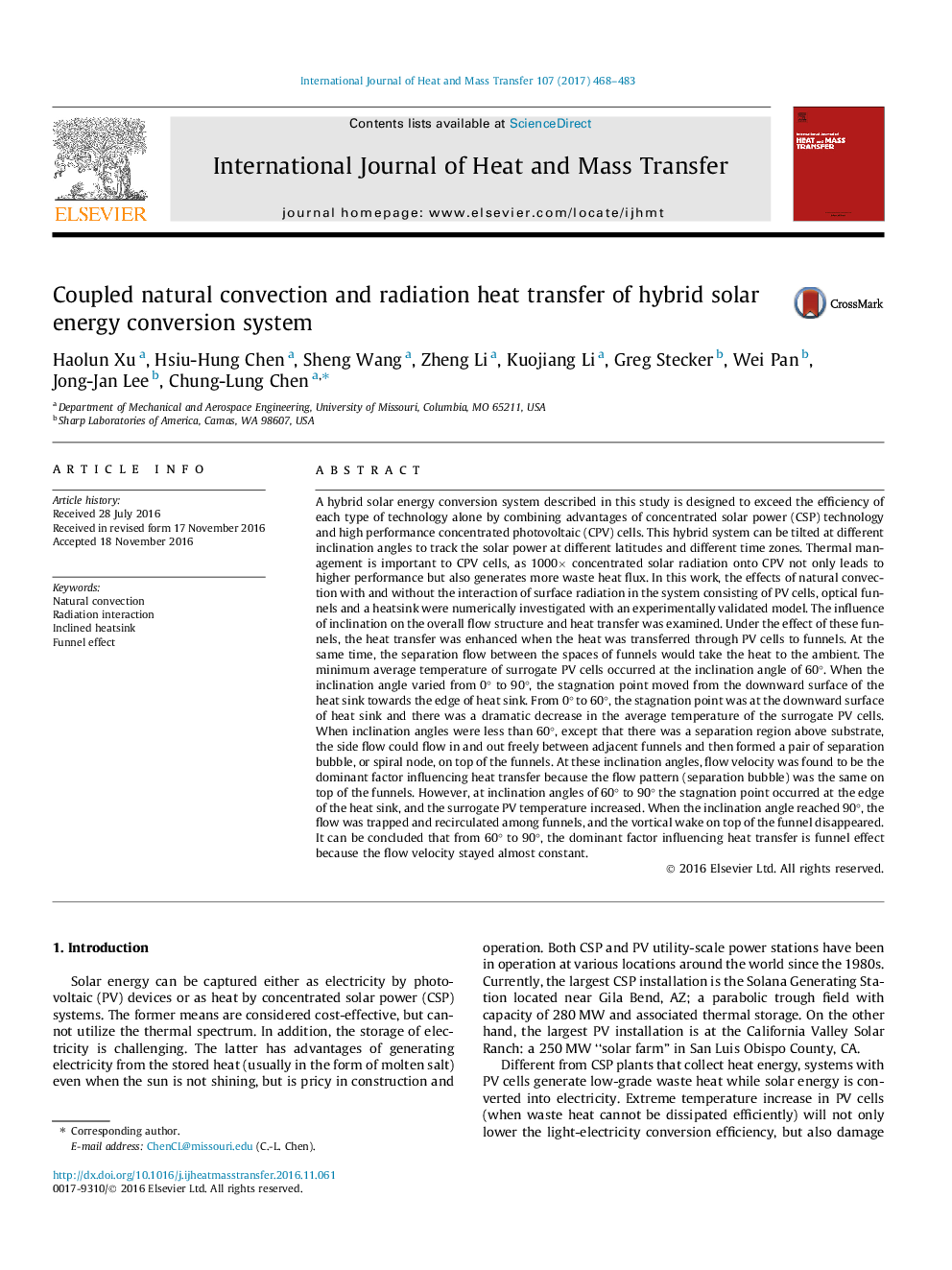| کد مقاله | کد نشریه | سال انتشار | مقاله انگلیسی | نسخه تمام متن |
|---|---|---|---|---|
| 4994603 | 1458035 | 2017 | 16 صفحه PDF | دانلود رایگان |
عنوان انگلیسی مقاله ISI
Coupled natural convection and radiation heat transfer of hybrid solar energy conversion system
ترجمه فارسی عنوان
انتقال گرما و گرمای تابشی ترکیبی از سیستم تبدیل انرژی خورشیدی
دانلود مقاله + سفارش ترجمه
دانلود مقاله ISI انگلیسی
رایگان برای ایرانیان
موضوعات مرتبط
مهندسی و علوم پایه
مهندسی شیمی
جریان سیال و فرایندهای انتقال
چکیده انگلیسی
A hybrid solar energy conversion system described in this study is designed to exceed the efficiency of each type of technology alone by combining advantages of concentrated solar power (CSP) technology and high performance concentrated photovoltaic (CPV) cells. This hybrid system can be tilted at different inclination angles to track the solar power at different latitudes and different time zones. Thermal management is important to CPV cells, as 1000à concentrated solar radiation onto CPV not only leads to higher performance but also generates more waste heat flux. In this work, the effects of natural convection with and without the interaction of surface radiation in the system consisting of PV cells, optical funnels and a heatsink were numerically investigated with an experimentally validated model. The influence of inclination on the overall flow structure and heat transfer was examined. Under the effect of these funnels, the heat transfer was enhanced when the heat was transferred through PV cells to funnels. At the same time, the separation flow between the spaces of funnels would take the heat to the ambient. The minimum average temperature of surrogate PV cells occurred at the inclination angle of 60°. When the inclination angle varied from 0° to 90°, the stagnation point moved from the downward surface of the heat sink towards the edge of heat sink. From 0° to 60°, the stagnation point was at the downward surface of heat sink and there was a dramatic decrease in the average temperature of the surrogate PV cells. When inclination angles were less than 60°, except that there was a separation region above substrate, the side flow could flow in and out freely between adjacent funnels and then formed a pair of separation bubble, or spiral node, on top of the funnels. At these inclination angles, flow velocity was found to be the dominant factor influencing heat transfer because the flow pattern (separation bubble) was the same on top of the funnels. However, at inclination angles of 60° to 90° the stagnation point occurred at the edge of the heat sink, and the surrogate PV temperature increased. When the inclination angle reached 90°, the flow was trapped and recirculated among funnels, and the vortical wake on top of the funnel disappeared. It can be concluded that from 60° to 90°, the dominant factor influencing heat transfer is funnel effect because the flow velocity stayed almost constant.
ناشر
Database: Elsevier - ScienceDirect (ساینس دایرکت)
Journal: International Journal of Heat and Mass Transfer - Volume 107, April 2017, Pages 468-483
Journal: International Journal of Heat and Mass Transfer - Volume 107, April 2017, Pages 468-483
نویسندگان
Haolun Xu, Hsiu-Hung Chen, Sheng Wang, Zheng Li, Kuojiang Li, Greg Stecker, Wei Pan, Jong-Jan Lee, Chung-Lung Chen,
